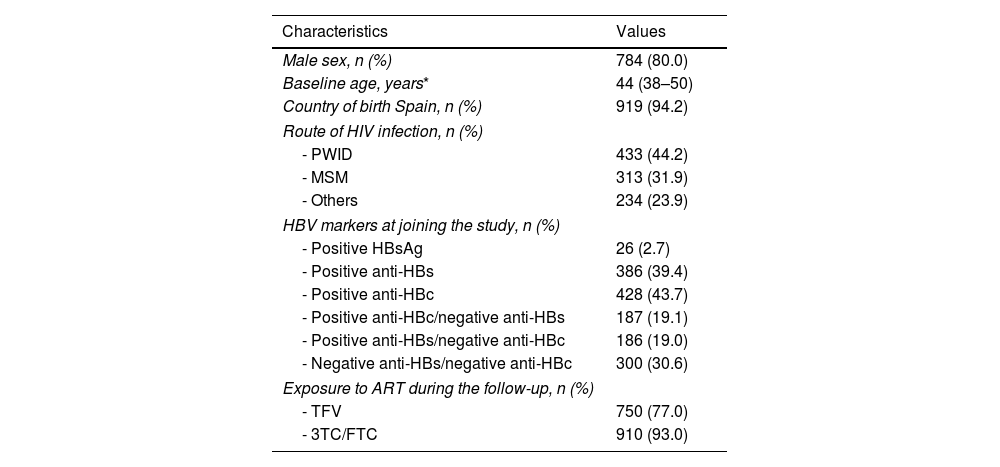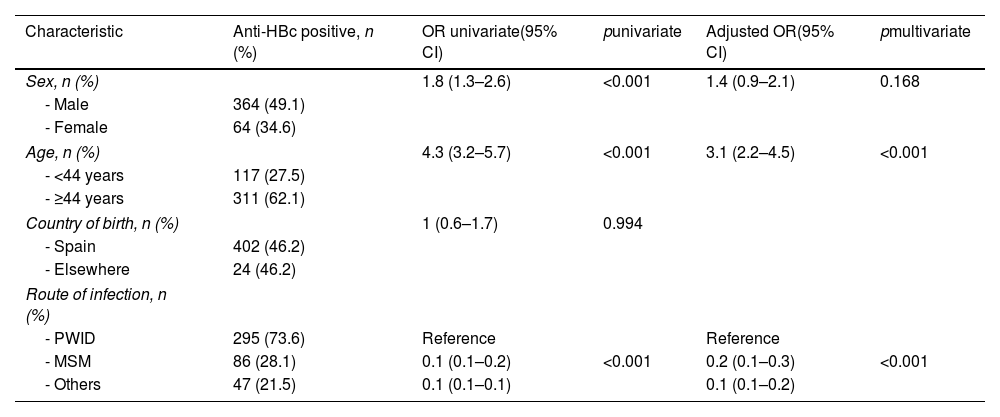The WHO proposed to achieve hepatitis B virus (HBV) elimination by 2030, but this goal is very difficult to attain. People living with HIV (PLWH) may represent a subset where microelimination can be reached sooner. This study aimed to assess the incidence of HBV infections and changes in the prevalence of active HBV infection among PLWH in Spain.
MethodsA prospective cohort study, including all PLWH attending a university hospital in Southern Spain from January 2011 to December 2022, was conducted. Serum HBV markers (HBsAg, anti-HBs, anti-HBc) were tested at baseline and at least yearly afterwards. Incident cases were identified by anti-HBc seroconversion.
ResultsNine hundred and eighty PLWH were included. At the beginning of the study, 26 (2.7% [95% CI: 1.7–3.8%]) tested positive for HBsAg, 428 (43.7% [95% CI: 42.8–49.4%]) for anti-HBc and 386 (39.4% [95% CI: 39.8–46.3%]) for anti-HBs. After a median (Q1–Q3) follow-up of 115 (35–143) months, two new infections were documented, yielding an incidence rate of 2.24 (95% CI: 0.27–8.1)/100,000 person-years. The prevalence of active HBV infection declined from 3.4% [95% CI: 2.0–5.0%] in 2011 to 2% [95% CI: 1.0–3.0%] in 2022 (p for linear trend=0.027). At the end of the study, 167 (24%) PLWH still were susceptible to HBV.
ConclusionsThe incidence of HBV infection among PLWH in Spain is close to the WHO target. The prevalence of active HBV infection has decreased substantially during the last 12 years. These data suggest that micro-elimination of HBV/HIV infection is on the track in Spain.
La OMS propuso la eliminación del virus de la hepatitis B (VHB) en 2030. Las personas que viven con VIH (PVVIH) pueden representar un subgrupo en el que la microeliminación podría alcanzarse antes. Nuestro objetivo fue evaluar la incidencia de infecciones por VHB y los cambios de prevalencia de la infección activa por VHB entre las PVVIH en España.
MétodosEstudio de cohorte prospectivo, incluyendo a todas las PVVIH atendidas en un hospital universitario en el sur de España desde enero de 2011 hasta diciembre de 2022. Se analizaron los marcadores séricos de VHB (HBsAg, anti-HBs, anti-HBc) al inicio y al menos anualmente.
ResultadosSe incluyeron 980 PVVIH. A la entrada en el estudio, 26 (2,7% [IC95%: 1,7-3,8%]) dieron positivo para HBsAg, 428 (43,7% [IC95%: 42,8-49,4%]) para anti-HBc y 386 (39,4% [IC95%: 39,8-46,3%]) para anti-HBs. Tras un seguimiento mediano (Q1-Q3) de 115 (35-143) meses, documentamos dos nuevas infecciones (tasa de incidencia de 2,24 [IC95%: 0,27-8,1]/100.000 personas-año). La prevalencia de la infección activa por VHB disminuyó del 3,4% [IC95%: 2,0-5,0%] en 2011 al 2% [IC95%: 1,0-3,0%] en 2022 (p para tendencia lineal=0,027). Al finalizar el estudio, 167 (24%) PVVIH seguían siendo susceptibles al VHB.
ConclusionesLa incidencia de infección por VHB entre las PVVIH en España se aproxima al objetivo de la OMS. La prevalencia de la infección activa por VHB ha disminuido sustancialmente en los últimos 12años. Estos datos sugieren que la microeliminación de la coinfección VHB/VIH está próxima en España.
Artículo
Socio de la Sociedad Española de Enfermedades Infecciosas y Microbiología Clínica

Para acceder a la revista
Es necesario que lo haga desde la zona privada de la web de la SEIMC, clique aquí













